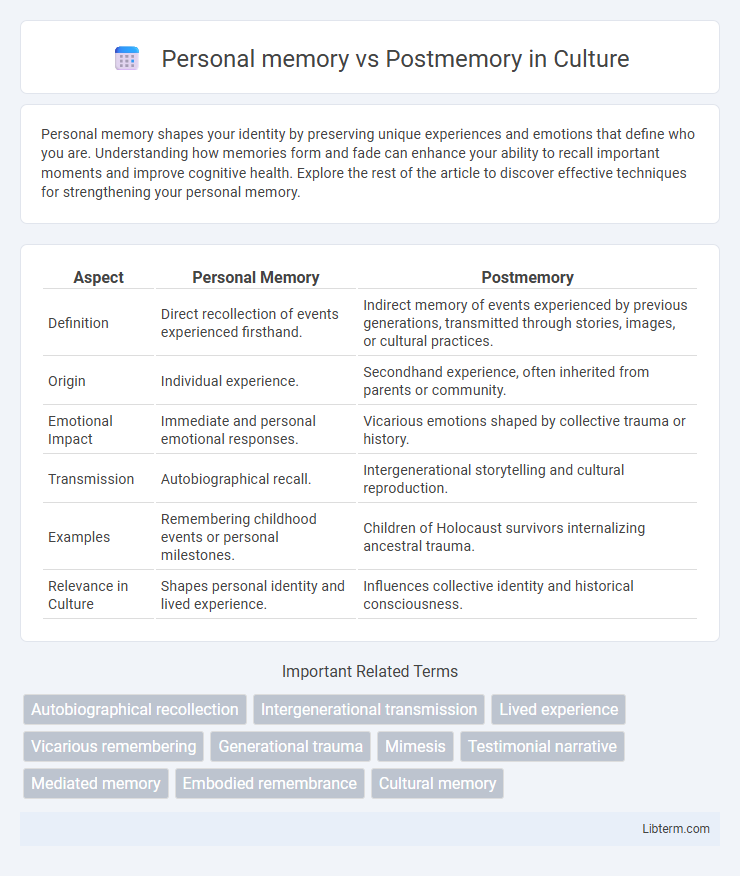Personal memory shapes your identity by preserving unique experiences and emotions that define who you are. Understanding how memories form and fade can enhance your ability to recall important moments and improve cognitive health. Explore the rest of the article to discover effective techniques for strengthening your personal memory.
Table of Comparison
| Aspect | Personal Memory | Postmemory |
|---|---|---|
| Definition | Direct recollection of events experienced firsthand. | Indirect memory of events experienced by previous generations, transmitted through stories, images, or cultural practices. |
| Origin | Individual experience. | Secondhand experience, often inherited from parents or community. |
| Emotional Impact | Immediate and personal emotional responses. | Vicarious emotions shaped by collective trauma or history. |
| Transmission | Autobiographical recall. | Intergenerational storytelling and cultural reproduction. |
| Examples | Remembering childhood events or personal milestones. | Children of Holocaust survivors internalizing ancestral trauma. |
| Relevance in Culture | Shapes personal identity and lived experience. | Influences collective identity and historical consciousness. |
Defining Personal Memory and Postmemory
Personal memory refers to the direct recollections an individual retains from their own lived experiences, often shaped by sensory details and emotional engagement. Postmemory describes the transmission of memories from one generation to the next, where the second generation inherits memories they did not personally experience, typically through stories, images, or cultural practices. This concept highlights the mediated and often affective nature of these inherited memories, distinguishing them from firsthand personal memory.
Historical Context of Postmemory
Postmemory refers to the relationship that the second generation or later have to traumatic events that they did not directly experience but that shape their identities through the stories, images, and behaviors transmitted by survivors. Its historical context is deeply rooted in collective traumas such as the Holocaust, genocides, or wars, where the scars are perpetuated across generations through familial and cultural narratives. Unlike personal memory, which arises from direct experience, postmemory relies on mediated recollections and emotional connections to historical trauma, influencing how communities remember and represent their past.
Mechanisms of Memory Transmission
Personal memory is directly encoded through lived experiences and neural pathways, relying on sensory input and emotional engagement to form autobiographical recall. Postmemory operates through mediated transmission, where subsequent generations acquire memories of events they did not personally witness via storytelling, images, and cultural artifacts, emphasizing cognitive and affective mechanisms like empathy and identification. Both mechanisms involve reconstructive processes that shape how memories influence identity and collective understanding over time.
Subjectivity in Personal Memory
Subjectivity in personal memory shapes how experiences are internally reconstructed, often influenced by emotions, biases, and individual perspectives. Unlike postmemory, which involves inherited or secondhand recollections transmitted across generations, personal memory is directly rooted in firsthand experience. This subjectivity highlights the unique, mutable nature of personal memory, distinguishing it from collective or postmemorial narratives.
Collective Trauma and Postmemory
Personal memory derives from direct experiences, while postmemory refers to the inherited recollections of collective trauma passed down through generations. Postmemory shapes identity by emotionally investing descendants in events they did not personally witness but are deeply affected by, such as genocide or war. This transmission influences cultural narratives and collective healing processes within communities impacted by historical trauma.
Authenticity and Limitations of Postmemory
Personal memory originates from direct experience, ensuring high authenticity through firsthand emotional and sensory engagement. Postmemory, by contrast, arises from secondhand transmission of memories, often through stories or images, which can lead to partial reconstruction and interpretive limitations. The authenticity of postmemory is inherently constrained by its mediated nature, risking distortion and selective representation over time.
The Role of Storytelling in Memory Shaping
Storytelling plays a crucial role in shaping both personal memory and postmemory by providing a narrative structure that helps individuals interpret and transmit experiences across generations. Personal memory involves firsthand recollections shaped by individual experiences, while postmemory refers to the inherited memories of events one did not directly experience, often mediated through stories from family or community members. These narratives enable the construction of collective identity and emotional connection, fostering understanding and meaning within intergenerational memory transmission.
Intergenerational Impact on Identity
Personal memory involves direct recollection of experiences, shaping individual identity through firsthand narratives. Postmemory refers to the inherited memories of subsequent generations, deeply influencing identity by connecting individuals to events they did not personally experience. The intergenerational impact on identity emerges as postmemory transmits trauma, culture, and history, forging a collective sense of self and belonging across family lines.
Memory, Media, and Representation
Personal memory anchors individual experiences encoded through direct sensory and emotional engagement, shaping identity via firsthand narrative recall. Postmemory arises in subsequent generations, transmitted through media such as photographs, films, and testimonies, mediating collective trauma and memory reconstruction beyond lived experience. Representation in media plays a crucial role in shaping both personal memory and postmemory by framing how memories are visualized, interpreted, and culturally internalized.
Navigating Personal Experience vs Inherited Memory
Personal memory stems from direct, lived experiences shaping individual identity and emotional understanding, while postmemory involves second-generation recollection inherited through narratives, photographs, and cultural artifacts. Navigating personal experience requires introspection and sensory recall, whereas engaging with postmemory demands interpreting transmitted emotions and fragmented histories to form a surrogate connection. The dynamic interplay between personal memory and postmemory influences how individuals construct meaning from past traumas and collective histories.
Personal memory Infographic

 libterm.com
libterm.com